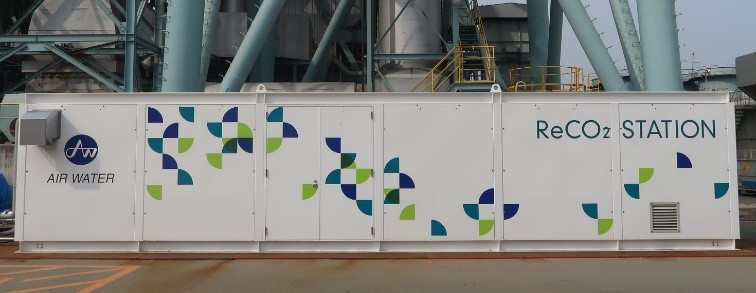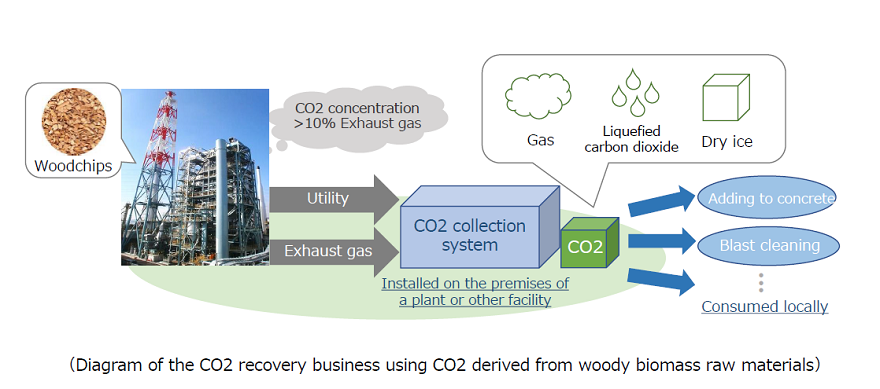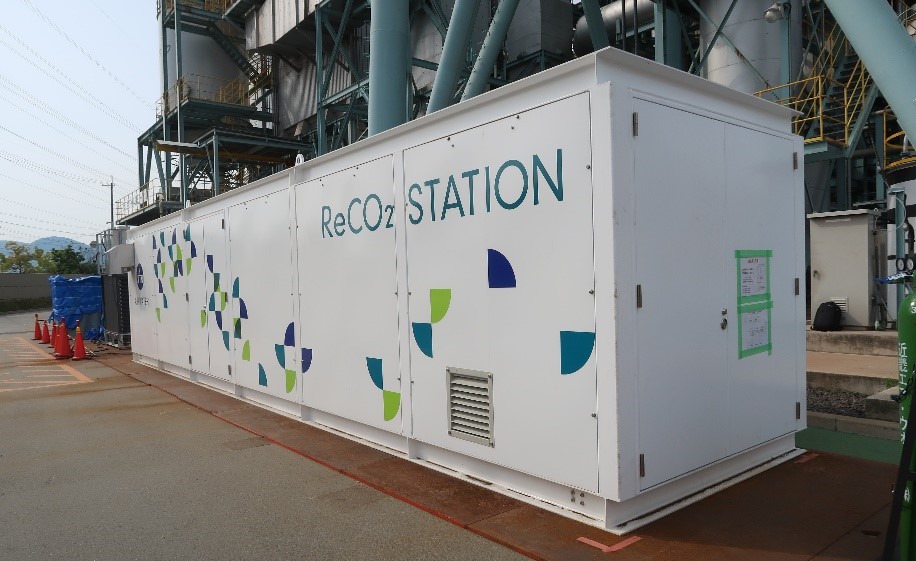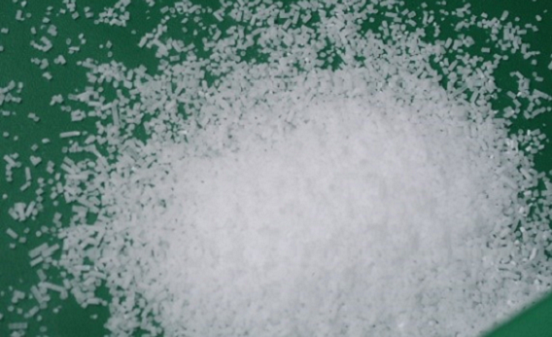Air Water Inc. (the "Company") is pleased to announce that it has developed the ReCO2 STATION. It is a highly efficient system that recovers low-concentration CO\( \sf _2 \) from sources such as the combustion exhaust gases from boilers and industrial furnaces (with a CO\( \sf _2 \) concentration of around 10%).
In addition, the Company installed this system in the Ako Plant of Nihonkaisui Co., Ltd., an Air Water Group company, in April 2022 to carry out a feasibility demonstration trial in which the system recovered CO\( \sf _2 \) from the combustion exhaust gases from its biomass power plant at an approximate purity of 99% to produce dry ice from the recovered CO\( \sf _2 \) and provide it to customers. The CO\( \sf _2 \) contained in the combustion exhaust gases from biomass power generation has properties that enable it to be carbon-neutral.*1 This means that the trial is the first attempt in Japan to produce dry ice that is not derived from fossil fuels.
*1 Plants emit CO\( \sf _2 \) when they are burned, but they absorb CO\( \sf _2 \) from the atmosphere through photosynthesis in their growth process. Therefore, they have no impact on the increase or decrease of CO\( \sf _2 \) in the atmosphere. (The emissions and the absorption offset each other.) This concept of a carbon cycle is referred to as carbon neutrality.
1. Background behind and objective of this development

The Japanese government announced its 2050 Carbon Neutral Declaration to encourage social action towards a carbon-free society. In April 2021, the Company began the CO\( \sf _2 \) Collection System Commercialization Project within the Group Technology Center, an internal organization for technology development. The world has yet to discover a low-cost, low-energy consumption technology for the separation and recovery of the low-concentration CO\( \sf _2 \) emitted from general small and medium-sized plants. Using the gas production and engineering technologies and knowledge as a manufacturer of carbon dioxide gas and dry ice that the Company has developed over many years, it is working hard to develop carbon dioxide capture, utilization and storage (CCUS) technologies.*2
In this situation, we successfully developed the ReCO\( \sf _2 \) STATION CO\( \sf _2 \) collection system using an original absorption and separation technology. Designed for the combustion exhaust gas from boilers, industrial furnaces and similar equipment, this highly efficient system recovers CO2 from combustion exhaust gases with an approximate CO\( \sf _2 \) concentration of 10%. In the future, separation and recovery technologies for various sources of CO\( \sf _2 \) emissions will be necessary. It is possible to use the ReCO2 STATION with the combustion exhaust gases from general factories. For the realization of a carbon-neutral society, it is important that society takes a carbon recycling perspective that works to recover and reuse CO\( \sf _2 \). This system is capable of using the CO\( \sf _2 \) it recovers to produce dry ice.
The Air Water Group will actively propose the introduction of this system as a way for customers to reduce their CO\( \sf _2 \) emissions as they work to achieve carbon neutrality. It will also consider using the systems installed at multiple customers as sources of supplying carbon dioxide gas and dry ice. This system will be very useful, especially to customers using carbon dioxide gas such as dry ice on site, given that the system is a one-stop solution paving the way for the recovery and utilization of CO\( \sf _2 \) on site.
The Company will provide value that is unique to industrial gas manufacturers using CO\( \sf _2 \) recovery technologies and its carbon dioxide gas supply network with the goal of building a model for the local recovery of CO\( \sf _2 \) for local utilization in the future.
*2 Carbon dioxide capture, utilization and storage (CCUS) is the proposal that CO2 be stored but also separated and recovered from the exhaust gases emitted from thermal power plans and factories and directly reused in the form of carbon dioxide gas and dry ice or indirectly reused as a raw material for chemicals, fuels, concrete and other products.
2. Overview of the ReCO\( \sf _2 \) STATION CO\( \sf _2 \) collection system
Name: ReCO\( \sf _2 \) STATION
("ReCO\( \sf _2 \)" means the recycling and reuse of CO\( \sf _2 \). It is a registered trademark.)
Dimensions: 12.2 m (L) x 2.4 m (W) x 2.8 m (H) (a 40-foot container size)
CO\( \sf _2 \) concentration recoverable from combustion exhaust gas: Approx. 10%
Dry ice production capacity: 100 kg per day
Applicable law: Class 2 high pressure gas production equipment (requiring only a notification report and no qualified personnel)
3. Technical features
- Employing a physical absorption method using a solid absorbent instead of the amine-based chemical absorption method
- An absorption process that minimizes energy loss has been developed for the high efficiency separation and recovery of low-concentration CO\( \sf _2 \)
- Small size achieved by simplifying the sequence of processes from the intake of combustion exhaust gases to dry ice production
- Paving the way for the reuse of the CO\( \sf _2 \) recovered from exhaust gases in a arbitrary state, either as gas, liquid or dry ice
4. Demonstration trial of dry ice production using CO\( \sf _2 \) derived from biomass power generation
In April 2022, the Company installed a pilot system in the Ako Plant in Ako-shi, Hyogo Prefecture. The plant is owned by Nihonkaisui Co., Ltd., an Air Water Group company. The Company carried out a demonstration trial of the feasibility of recovering CO\( \sf _2 \) and producing dry ice from the combustion exhaust gases from Nihonkaisui's Ako No. 1 Biomass Power Plant.

Woody biomass power plants mainly burn woodchips. Woodchips are from trees, and trees absorb CO\( \sf _2 \) from the atmosphere and fix it in place as a part of photosynthesis during their growth. The CO\( \sf _2 \) they fix offsets the CO\( \sf _2 \) emissions from their combustion as a source of energy. Thus, a feature of woodchips is their carbon neutrality. For this reason, the dry ice made from the CO\( \sf _2 \) emitted from the woody biomass power plant is a carbon-neutral product.
In the feasibility demonstration trial for cleaning applications, the dry ice that was produced was provided to neighboring users. This confirmed there were no problems in quality or performance. This was the first attempt in Japan to produce and utilize dry ice not derived from fossil fuels. The dry ice produced by this project was a product with increased environmental value.
<Reference>
◆Supply of carbon dioxide gas and dry ice
Liquefied carbon dioxide gas and dry ice are produced from by-product gasses with a high CO\( \sf _2 \) concentration of 90% or more generated from the combustion of fossil fuels generally at petrochemical plants, oil refineries and other facilities.
◆Ako Biomass Power Plant of Nihonkaisui Co., Ltd.
Nihonkaisui Co., Ltd. is a leading company in the salt industry. It produces 400 kilotons of salt per year for consumers and for business use. It consumes electric power in the salt production process and independently possesses power generation facilities. At its Ako Plant, the No. 1 woody biomass power plant and the No. 2 woody biomass power plant began operating in 2015 and 2021, respectively. It utilizes carbon-neutral renewable energy from woody biomass fuels to reduce CO\( \sf _2 \) emissions. It employs wood from forest thinning and other wood left in forests generated in neighboring areas as part of its woody biomass fuels to aid the development of local forestry and lumber industries.
[Contact for inquiries]
AIR WATER INC.: Office of Corporate Communications, E-mail: info-h@awi.co.jp



